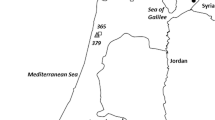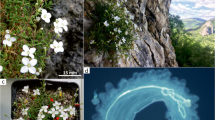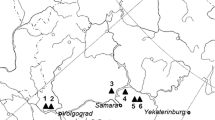Summary
Several populations of two species of the genus Limnanthes, (L. alba, an outbreeder and L. floccosa, an inbreeder) were examined with respect to variability of fifteen quantitative characters, allozyme variation at 11 loci, and response to different pollination conditions and moisture stress. Nearly equal amounts of phenotypic variability were found in the two species. L. alba had higher within-family variability than L. floccosa, but this result was highly heterogeneous among characters. A study of between- and within-population variance estimates did not reject the null hypothesis that L. alba and L. floccosa are similar with regard to the partitioning and amount of variability for quantitative characters. However, allozyme variation at 11 loci in a large number of populations showed L. alba to be highly polymorphic in contrast to the virtual monomorphism within L. floccosa populations. The average number of alleles per locus in L. alba and L. floccosa was 1.97 and 1.02, respectively, and on an average, L. alba and L. floccosa populations had 63% and 3% loci with polymorphism, respectively. Three groups of allozyme allelic combinations emerged which correlated well with the taxonomic delineation of allogamous L. alba, three semi-autogamous L. floccosa forms and two autogamous L. floccosa forms.
All taxa showed a significant reduction in the seed output per plant due to moisture stress. L. alba suffered a further loss of fecundity under the paucity of pollinators, L. floccosa ssp. floccosa showed no significant effect from this factor, whereas L. floccosa ssp. grandiflora exhibited a curvilinear response which peaked at ‘partial pollination’ and decreased to a lower level at ‘full pollination.’
The geographic distribution of the two species with regard to the temperature and rainfall distribution did not suggest L. floccosa to be living in drier marginal areas. Patterns of variation in flowering time showed L. alba to be less variable than L. floccosa. Overall, there seemed to be little direct support for the thesis that inbreeding species originated from outcrossing taxa in marginal environments as a direct adaptation to a shortened growing season of xeric environments and to the lack of pollinators. Alternative hypotheses suggest that autogamy in L. floccosa might have evolved as a reproductive isolating barrier acting through either cleistogamy or divergence in flowering times.
Similar content being viewed by others
Literature
Arroyo, M.T.K.: Chiasma frequency evidence on the evolution of autogamy in Limnanthes floccosa (Limnanthaceae). Evolution 27, 679–688 (1973a)
Arroyo, M.T.K.: A taximetric study of infraspecific variation in autogamous Limnanthes floccosa (Limnanthaceae). Brittonia 25, 177–191 (1973b)
Arroyo, M.T.K.: Electrophoretic studies of genetic variation in natural populations of allogamous Limanthes alba and autogamous Limnanthes floccosa (Limnanthaceae). Heredity 35, 153–164 (1975)
Brown, A.H.D.: Enzyme polymorphisms in plant populations. Theor. Pop. Biol. (in press)
Darwin, C.: The effects of cross and self-fertilization in the vegetable kingdom. New York: D. Appleton & Co. 1876
Gottlieb, L.D.: Electrophoretic evidence and plant systematics. Ann. Mo. Bot. Garden 64, 161–180 (1977)
Hillel, J.; Feldman, M.W.; Simchen, G.: Mating systems and population structure in two closely related species of the wheat group. I. Variation between and within populations. Heredity 30, 141–167 (1973)
Holland, R.F.; Jain, S.K.: Island biogeography of species diversity in the vernal pools of California. Amer. Natur. (Submitted for publication)
Jain, S.K.: Evolution of inbreeding in plants. Ann. Rev. Ecol. System 7, 469–495 (1976)
Jain, S.K.: Optimal strategies: Polymorphism, plasticity and homeostasis. In: Population Biology of Plants (eds. Solbrig, O.T.; Jain, S.K.; Johnson, G.B.; Raven, P.H.). New York: Columbia Univ. Press 1978
Kalin, M.T.: The evolution of autogamy in Limnanthes, section Inflexae (Limnanthaceae). Ph. D. Thesis, Univ. of Calif., Berkeley (1971)
Levins, R.: Evolution in Changing Environments. Princeton Univ. Press 1967
Lloyd, D.G.: Evolution of self-compatibility and racial differentiation in Leavenworthia (Cruciferae). Contr. Gray Herb. Harvard Univ. 195, 3–134 (1965)
Mason, C.T.: A systematic study of the genus Limnanthes R. Br. Univ. Calif. Publ. Bot. 25, 455–512 (1952)
Shaw, C.R.; Prasad, R.:Starch gel electrophoresis of enzymes — a compilation of recipes. Biochem. Genet. 4, 297–320 (1970)
Solbrig, O.T.; Rollins, R.C.: The evolution of autogamy in species of the mustard genus Leavenworthia. Evolution 31, 265–281 (1977)
Sokal, R.R.; Rohlf, F.J.: Biometry. San Francisco: Freeman 1969
Stebbins, G.L.: Variation and Evolution in Plants. New York: Columbia Univ. Press 1950
Thorp, R.W.: Systematics and ecology of the subgenus Diandrena (Hymenoptera: Andrenidae). Univ. Calif. Publ. Entom. 52, (1969)
Author information
Authors and Affiliations
Additional information
Communicated by R.C. Lewontin
Rights and permissions
About this article
Cite this article
Brown, C.R., Jain, S.K. Reproductive system and pattern of genetic variation in two Limnanthes species. Theoret. Appl. Genetics 54, 181–190 (1979). https://doi.org/10.1007/BF00263049
Received:
Issue Date:
DOI: https://doi.org/10.1007/BF00263049




